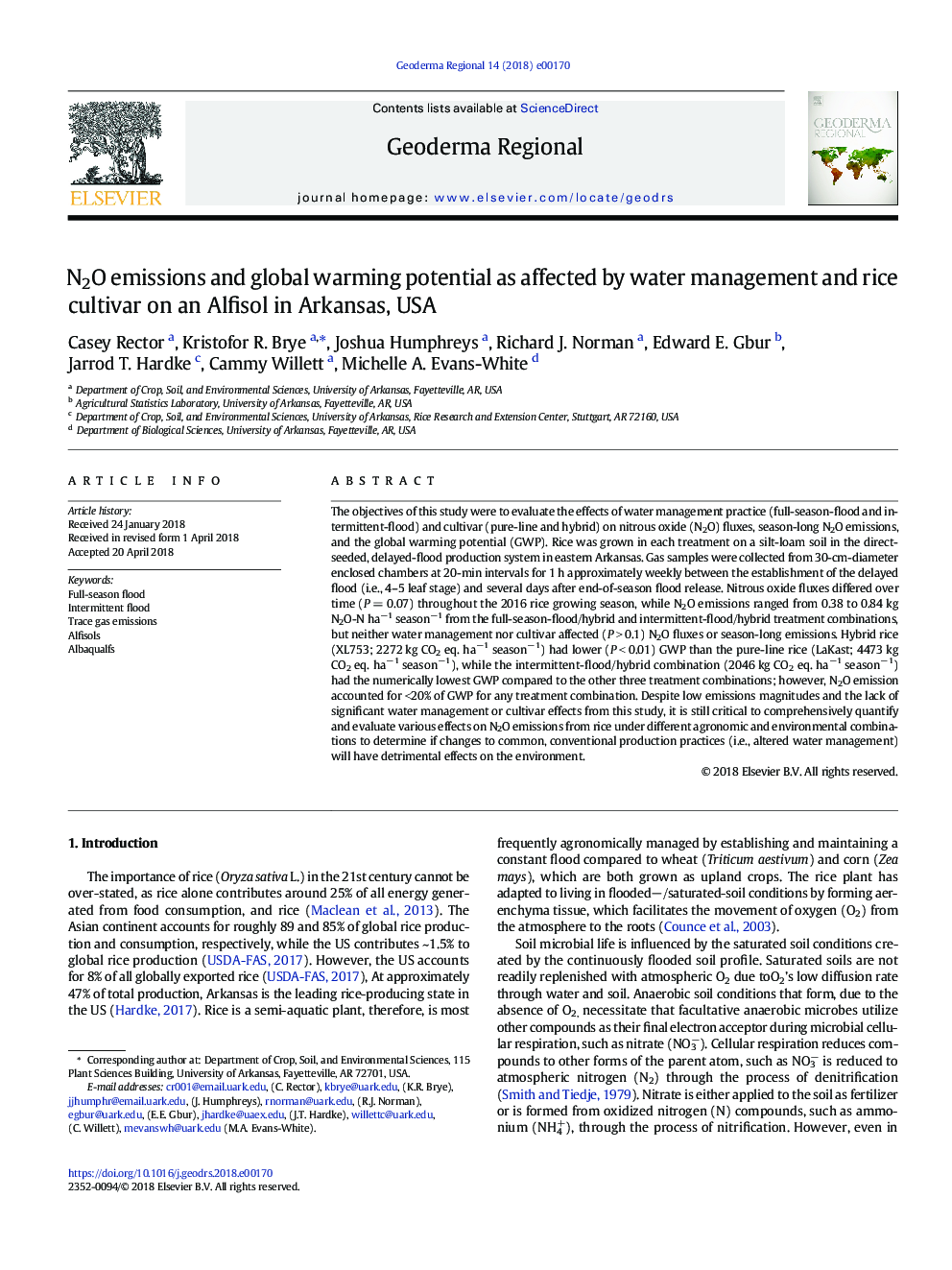| کد مقاله | کد نشریه | سال انتشار | مقاله انگلیسی | نسخه تمام متن |
|---|---|---|---|---|
| 8873244 | 1623002 | 2018 | 12 صفحه PDF | دانلود رایگان |
عنوان انگلیسی مقاله ISI
N2O emissions and global warming potential as affected by water management and rice cultivar on an Alfisol in Arkansas, USA
ترجمه فارسی عنوان
انتشار گازهای نیتروژن و پتانسیل گرم شدن زمین تحت تأثیر مدیریت آب و ارقام برنج در یک آلفیسول در آرکانزاس، ایالات متحده آمریکا
دانلود مقاله + سفارش ترجمه
دانلود مقاله ISI انگلیسی
رایگان برای ایرانیان
موضوعات مرتبط
مهندسی و علوم پایه
علوم زمین و سیارات
فرآیندهای سطح زمین
چکیده انگلیسی
The objectives of this study were to evaluate the effects of water management practice (full-season-flood and intermittent-flood) and cultivar (pure-line and hybrid) on nitrous oxide (N2O) fluxes, season-long N2O emissions, and the global warming potential (GWP). Rice was grown in each treatment on a silt-loam soil in the direct-seeded, delayed-flood production system in eastern Arkansas. Gas samples were collected from 30-cm-diameter enclosed chambers at 20-min intervals for 1â¯h approximately weekly between the establishment of the delayed flood (i.e., 4-5 leaf stage) and several days after end-of-season flood release. Nitrous oxide fluxes differed over time (Pâ¯=â¯0.07) throughout the 2016 rice growing season, while N2O emissions ranged from 0.38 to 0.84â¯kg N2O-Nâ¯haâ1 seasonâ1 from the full-season-flood/hybrid and intermittent-flood/hybrid treatment combinations, but neither water management nor cultivar affected (Pâ¯>â¯0.1) N2O fluxes or season-long emissions. Hybrid rice (XL753; 2272â¯kg CO2 eq. haâ1 seasonâ1) had lower (Pâ¯<â¯0.01) GWP than the pure-line rice (LaKast; 4473â¯kg CO2 eq. haâ1â¯seasonâ1), while the intermittent-flood/hybrid combination (2046â¯kg CO2 eq. haâ1â¯seasonâ1) had the numerically lowest GWP compared to the other three treatment combinations; however, N2O emission accounted for <20% of GWP for any treatment combination. Despite low emissions magnitudes and the lack of significant water management or cultivar effects from this study, it is still critical to comprehensively quantify and evaluate various effects on N2O emissions from rice under different agronomic and environmental combinations to determine if changes to common, conventional production practices (i.e., altered water management) will have detrimental effects on the environment.
ناشر
Database: Elsevier - ScienceDirect (ساینس دایرکت)
Journal: Geoderma Regional - Volume 14, September 2018, e00170
Journal: Geoderma Regional - Volume 14, September 2018, e00170
نویسندگان
Casey Rector, Kristofor R. Brye, Joshua Humphreys, Richard J. Norman, Edward E. Gbur, Jarrod T. Hardke, Cammy Willett, Michelle A. Evans-White,
